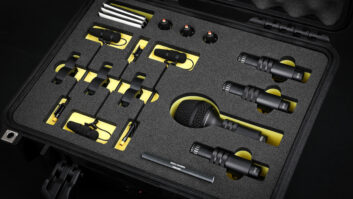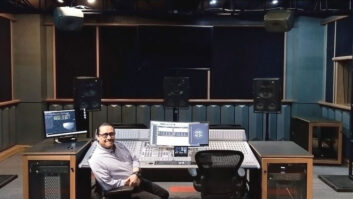
Photo by Neil Krug
Like a lot of people, my first exposure to the duo known as First Aid Kit—Swedish sisters Klara and Johanna Söderberg—came from seeing their gorgeous 2008 YouTube cover version of Fleet Foxes’ “Tiger Mountain Peasant Song.” At the time, Klara was just 15, Johanna 17; but those voices! Since their humble video introduction to the world—which has been viewed close to 4 million times—their career has taken off and they’ve become darlings of the indie folk/country scene with their sumptuous harmonies and affecting songwriting. For their past two albums—2012’s The Lion’s Roar and the latest release, Stay Gold—the young women (now 20 and 22) have been ably assisted by the Nebraska-based producer/engineer/multi-instrumentalist Mike Mogis, best known for his long association with Conor Oberst in both Bright Eyes and the acclaimed indie “super-group” Monsters of Folk (which also includes She & Him’s M. Ward and My Morning Jacket front man Jim James).
Klara Söderberg has said that listening to Bright Eyes’ I’m Wide Awake, It’s Morning was an inspiration for her to get her first guitar at age 13, and she credits Oberst for steering her toward some of his influences, from Gram Parsons and Emmylou Harris to Bob Dylan and various ’60s folkies. So you can imagine what a thrill it was for her and sister Johanna (who plays keyboards and mainly sings harmonies) to get to meet Oberst, tour with Bright Eyes, and then make two albums helmed by Mogis. Oberst co-wrote and sang on one track on The Lion’s Roar, and Bright Eyes’ Nate Wolcott has played keyboards on both of the Mogis-produced First Aid Kit albums, and also helped with arrangements.
Both albums were recorded and mixed in Omaha at Mogis’ wondrous ARC Studios, which he notes “is behind my house. It was originally an indoor basketball court, but we turned it into two studios. The ‘A’ room is where I spend most of my time. It’s got a vintage Neve 8068 board. The broker we bought it from said it was originally installed at Air Studios in London and then moved to Air Studios in Lyndhurst; evidently, it was originally commissioned for the room where George Martin was working. It has 48 input modules with [Neve] 1081s, but it doesn’t have a monitor section. It’s a great console. It was completely refurbished by Fred Hill, who’s based in Nashville.” Designer/acoustician Wes Lachot lowered the ceiling from more than 30 feet down to 17, still plenty big for a “live” room.
Mogis says the recording methodology for the two First Aid Kit albums he worked on was similar, though obviously the second time around—for Stay Gold—they were more experienced and more confident. “On the first record we did together, they didn’t come in with too much in mind. They had never really been in a studio before. They had recorded everything with their dad [Benkt Söderberg, formerly of the early ’80s rock band Lolita Pop] at their house. When they came here, the lead singer [Klara] was 17 years old, so she had just graduated from high school [outside of Stockholm]. I was amazed they were so easy to work with. I was afraid they’d be nervous. But most of the vocals were recorded live as we were laying down the drums—I had the girls in a room together standing side by side, and the drums in the main tracking room, and then their dad was also playing bass in the main tracking room. About 60 to 70 percent of the vocals were from those basic tracking sessions. To this day, they’re probably the best singers I’ve worked with.”
The engineer’s mics of choice for the sisters on both albums was a pair of sequentially numbered Neumann M 49s. “When they started at age 13, up until right now, they’ve never recorded [their vocals] separately,” he says. “They’ve always recorded together, right next to each other. I guess we did add third harmonies sometimes, but the fundamental track is always the two of them.” For the new album, Mogis used a Fairchild 670 compressor on the vocals, as well as the Neve’s warm-sounding mic pre’s.
“[For the Stay Gold sessions] they came in wintertime and one was just getting over a cold, while her sister was just getting it. We had to do some basic tracks the next day, so we were not able to keep any of those live vocal tracks. We had to wait a week, but we still ended up keeping the lead vocal on the majority of Stay Gold from the live takes.”
The basics were cut with Klara also strumming and fingerpicking acoustic guitar and Johanna playing a Nord keyboard, “stacked full of organ, Mellotron and all the sounds we use [on the albums] but usually redo later,” Mogis says. Most of the acoustic guitar was also replaced later. The overdub sessions included string and woodwind parts played by local symphony musicians, and various keyboard, pedal steel, guitar and mandolin accents added by Walcott and Mogis. “We took a lot of inspiration from Townes Van Zandt’s Our Mother the Mountain, which has a lot of woodwind and strings, played in a specific style—kind of creaky, slightly folky,” Mogis notes.

Far from being “creaky,” Stay Gold—First Aid Kit’s major-label debut (Columbia)—is smooth as honey and glistens brightly, even with the down-home feel in some of the vocals and its occasionally dark introspection. “They’re barely into their 20s and they’re so talented,” Mogis says. “They have almost unlimited potential because they can do anything. They love all styles of music and they absorb whatever’s around them and put it through their filters and their sensibilities, and out comes something special and unique.”
Online Extras: More from producer/engineer/mixer Mike Mogis on First Aid Kit and the making of Stay Gold.
On his initial exposure to First Aid Kit: “I heard their album on Wichita [The Big, The Black & the Blue] through Conor [Oberst] and we happened to be in Austin, Texas, playing the Austin City Limits Music Festival with Monsters of Folk, and he said there’s this band, First Aid Kit, and I should go check them out. So we all went to check them out and I was blown away. Their show was in the middle of the afternoon, one of the first slots, and there weren’t that many people there yet; maybe 300 people in front of the stage, and there was house music playing in a tent next door to them. And they walk out and its just two girls and an acoustic guitar and everyone who was there was just completely focused on them, so that all the other sound sort of disappeared. They were very engaging. At the end of the set, I turned around and there were thousands of people around me—a bunch of other folks had filled in, because [First Aid Kit] drew everyone into their net, into their world, with their songs. I was really, really impressed with their stage presence and their songs and their voices, obviously, so I contacted their manager and sent a text that said, ‘Hey, let’s make a record together.’”
On the approach to Stay Gold vs. the previous album, The Lion’s Roar: “What’s that saying—‘If it’s not broke, don’t fix it’? We didn’t want to reinvent the band. We wanted to build slightly off The Lion’s Roar and not take too much of a left turn. I felt it was important to stay true to the songs’ intent and what they had in mind when they were writing it. There’s a little bit more of a poppy aesthetic with the new material; slightly snappier structures and arrangements.”
On the drums on the two albums: “We had a different drummer [on Stay Gold] and that greatly influenced the tracks. Mattias [Bergqvist, who was on The Lion’s Roar] is more of rock drummer. The drummer for this record [Niklas Lindstrom] is more of a jazz drummer, so he hits really softly. For some of the louder rock songs, I had him overdub to himself, sometimes in the hallway here, for a big roomy sound. We had to layer the drums a lot more on this record to get the results we were looking for. But he could interpret anything you would throw at him and make it sound really musical. In one song it feels like there are three drum kits playing that have different snare drums; maybe one’s with brushes, one’s with sticks. There was a little bit more experimentation and playfulness going between the kits.”
On planning for overdubs: “We spent a little time doing preproduction work of them sending me demos from Stockholm. They put in some of their ideas. I wanted to step up the musicality of it all, so we’d talk about: ‘This song should have clarinet and flute, which is our standard woodwind section, and this song should just have clarinet, and this one should have flute and strings.’ We figured out which songs they felt would benefit from strings and woodwinds and we pretty much stuck to it. We talked about places to put them and motifs to use before we started recording.”







